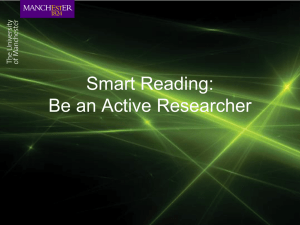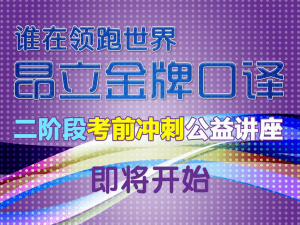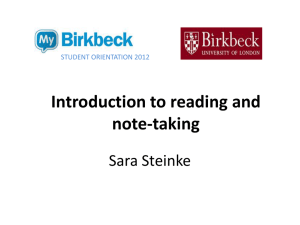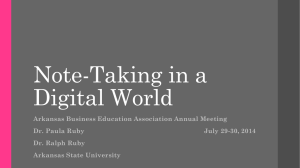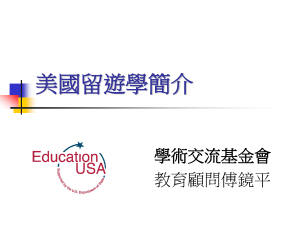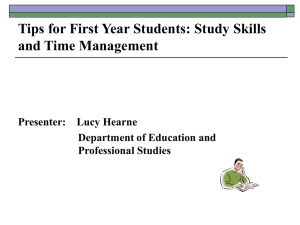Improve Learner Note-Taking Skills
advertisement
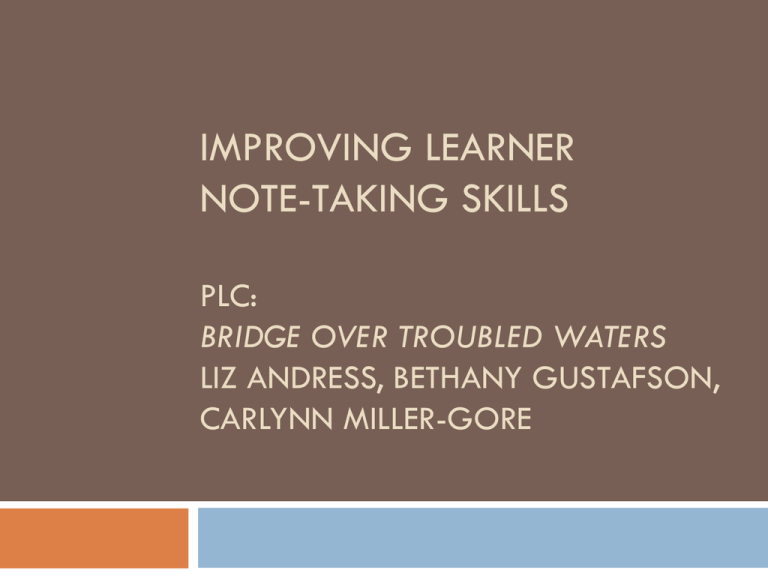
IMPROVING LEARNER NOTE-TAKING SKILLS PLC: BRIDGE OVER TROUBLED WATERS LIZ ANDRESS, BETHANY GUSTAFSON, CARLYNN MILLER-GORE SMART Goal: Students in our FastTRAC bridge and integrated classes will use effective note-taking tools and strategies for lectures, videos and readings that increase their comprehension and improve their performance on course assignments. To meet this goal, we will: research note-taking strategies identify 3-5 tools/strategies to teach teach/model/practice the strategies with our students evaluate the strategies’ effectiveness integrate the best strategies into our on-going teaching in these courses. STRATEGIES “SQ2R” Reading Comprehension Strategy Scan Question Read Recite =========== Teach – model – practice Gradual release – detailed note-taking guides partial guides student-generated guides Video note-taking guides Charts Cloze ============ Preview guide – what are we listening for Model note-taking on board – short, abbrevs. Review – talk to partner, key points, fill in missed Note-Taking Self Evaluation Rubric Uses self-eval model developed by a PLC in a previous year Breaks down note-taking into more defined areas to help learners be aware of how to learn a complex skill. Examples “I know how to use different styles of note-taking,” and “I write the date at the top of the page.” Cornell Notes Main ideas: Details: What are Cornell 2 column note taking format notes? Main ideas/major points in narrow column Details in the wider column Benefits: Helps with review and self quizzing Summary: Cornell notes and SQ2R were effective in improving learners’ note taking skills… Note taking is… Recording selected information from a source. Examples: Guided note taking from a textbook using SQ2R method Listing new terms/definitions on flashcards Creating flow charts or other graphic organizer to group terminology/concepts Taking notes from a lecture using Cornell method or other Using a cloze guide to take notes from a video Dictation Completing “soft-skills” rubric for team work, presentation, organizational skills, etc… Using notes to further learning with assignments such as jigsaws, essays, presentations, etc… Sample application of Integrated Medical Terminology note-taking process to Bloom’s Taxonomy Knowledge – create medical terminology flashcards Comprehension – organize terms in categories (body parts, diseases, procedures) Application – complete sample medical record document applying chapter medical terms, describe flow of terms as applied to a body system Analysis – create medical record document including descriptions of symptoms, tests, diagnoses, treatments Synthesis – communicate summary of symptoms, tests, diagnoses, treatments in layman’s terms as well as medical terminology in a jigsaw activity Evaluation – complete rubric of jigsaw activity, determining how to improve summary and communication based on selfevaluation and peer evaluation LESSONS LEARNED / MOVING FORWARD Liz: Develop student self-awareness (meta-cognition), not just discreet skills Impact on my teaching practice: SQ2R is integrated into my two academic support classes Video and presentation note-taking guides – adding more all the time, in all classes To be improved – lecture note-taking skill development Bethany: Help learners gradually build note-taking skills in manageable pieces, rather than trying to teach everything at once. Impact on my teaching practice: Explicitly taught Cornell method for lectures and readings Tried to break note taking down into steps Going forward, I plan to incorporate note-taking skills in suitable ways at all levels Carlynn: Students need to be actively involved in note-taking during reading, lectures, videos, field trips, etc… to maximize learning. Passive participation does not allow for students to create successful learning habits as a student or employee. Impact on my teaching practice: Continue to use SQ2R for textbook reading assignments. Continue to model the use of note taking tools during lectures. Continue to encourage students create note taking models that adapt to the current environment. Create more accountability around lecture note taking (make note taking a graded assignment). Continue to use self-evaluation note taking rubrics. Potential applications for larger Hubbs community Encourage learners to focus on meaning, not exact words, when writing down things they hear in class Underlying skills of note-taking can be taught at all levels (date top of page, today’s notes on the page after yesterday’s, etc) A future class focused on note-taking skills? RESOURCES Resources on Hubbs Site Available on the Hubbs website via the following path: Hubbs Center Home > Staff > Curriculum > Hubbs Vision Wedges URL: sites.google.com/site/hubbsvision/ Additional Note Taking Resources Texts Ten Skills You Really Need to Succeed in School by John Langan (2002) Talk it Over! Listening, Speaking and Pronunciation by Joanne Kozyrev (2006) – (available in multiple levels) Articles Konrad, M., Joseph, L., & Eveleigh, E. (2009). A meta-analytic review of guided notes. Education and Treatment of Children, 32(3), 421-444. Makany, T., Kemp, J., & Dror, I. (2009). Optimising use of note-taking as an external cognitive aid for increasing learning. British Journal of Educational Technology, 40(4), 619-635. Websites Intervention Central http://www.interventioncentral.org/academicinterventions/study-organization/guided-notes-increasing-student-engagementduring-lecture Eduplace.com - Graphic Organizers http://www.eduplace.com/graphicorganizer/
